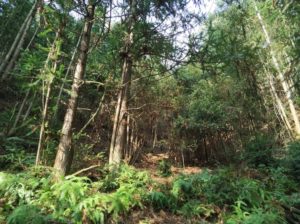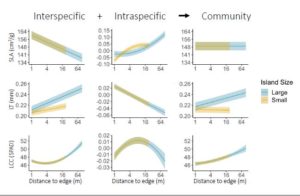New publication: the power of individuals (plants, that is)
Species-averaged trait response cannot represent community-wide patterns

Aerial view of the Thousand Island Lake islands at daybreak. Photo: Pan Jingcao.
Looking for patterns in the morphological features of plants has been widely used to test ecological concepts at a range of spatial and temporal scales. For example, using variation in these traits to explain mechanisms underlining plant community responses to environmental change is becoming an increasingly popular focus. However, the vast majority of this work on trait ecology simply measures species-level trait means from a small subset of individuals, and use these to calculate ‘community-weighted trait-mean’ (CWM) values. This approach can be problematic if there is high variance or skewness in trait values among individuals within the same species, or if directional shifts in selection for individual-level traits along environmental gradients can run counter to species-level trait responses. In a new paper recently published in Ecography, we explored the potential pitfalls of a ‘species-mean’ approach by examining both within- and between-species variation in key plant traits. We found that a failure to consider the full extent of individual-level trait variation might lead to misleading conclusions on community-wide patterns along environmental gradients.

Scoping new islands for potential sites. Photo: Raphael Didham.
Our research was conducted across 20 islands in the Thousand Island Lake (or Qiandao Lake), eastern China. Thousand Island Lake was formed in 1959 as a reservoir after the construction of a hydroelectric station on the Xin’an river. The inundation of this hilly area created a lake covering an area of 581 km2, with more than 1000 islands created from former mountain tops. During dam construction, the forests in this area were clear-felled, but were then largely protected by law with little subsequent human disturbance during regrowth. Until recently, after more than 60 years of natural succession, around 90% of total island area is covered by secondary forest, with mainly Masson pine dominated canopy and broad-leaved woody plants in the understory. Forest patches on these islands represent an ideal system in which to study ‘edge effects’; the impact of forest fragmentation on community structure and function. This is because the islands have relatively ‘fixed’ edges, due to a constant water level and the surrounding landscape matrix (i.e., water) being the same around all islands. Thus, on islands in Thousand Island Lake, plants at forest edges have experienced relatively consistent selection regimes over the recent 60 years, providing us with a perfect and unique opportunity to study plant community trait shift patterns in response to edge effects in a fragmented landscape.

Forest view from the understorey on one of the larger islands. Photo: Shilu Zheng.
Over two years from 2017, we implemented a stratified random sampling design from forest edge to the interior on each of the 20 islands, sampled over 30 000 leaves from around 3000 trees representing 68 species, and measured five leaf traits for all individuals: leaf area, specific leaf area (i.e., leaf area to dry mass), leaf thickness, lead dry matter content (i.e., leaf dry mass to fresh mass), and leaf chlorophyll content. Based on these data, we found that for all studied leaf traits, a relatively large portion of total trait variance was attributed to trait variation between species (i.e., interspecific trait variation) rather than trait variation within species (i.e. intraspecific trait variation). Such that for leaf area, specific leaf area and leaf thickness, over 80% of trait variance was attributed to interspecific differences, with only c. 10% to intraspecific variation. At first glance, these results seem to support the statement that intraspecific trait variation is negligible compared to interspecific differences, and that measuring individual-level trait values could be viewed as a waste of time and effort.

Trait shifts in response to edge and area effects at species level (first column), within species (second column), and for the overall community including both inter- and intraspecific trait variation (third column). Here we show examples of negative covariance between inter- and intraspecific trait responses in specific leaf area (SLA), leaf thickness (LT), and leaf chlorophyll content (LCC). (Modified from Fig. 2 of Zheng et al. 2022)
However, trait response patterns tell a different story. We assessed community-wide trait shifts along distance-to-edge gradients, comparing community-wide patterns using species-averaged trait values (i.e., CWM approach) versus individual-level trait values. Surprisingly, there is a mismatch between these two approaches. Neglecting intraspecific differences can mask ‘real’ community-wide responses to environmental gradients, even if the contribution of intraspecific trait variation is extremely small compared to the contribution from interspecific trait differences. For example, looking at specific leaf area, although over 80% of trait variance was attributed to interspecific trait differences, the contrasting directions of inter- vs. intraspecific trait shifts in response to edge effects resulted in non-significant overall community-wide trait responses. In such a scenario, only examining community-wide response using CWM with species-mean trait values could lead to flawed conclusions.
Our study has added weight to the emerging argument that for answering many ecological questions, it is important to consider both intra- and inter-species variation in traits. We were able to show that in order to obtain reliable patterns of community-wide response to environmental gradients, it is crucial to explicitly incorporate individual-level trait responses. While such an approach can quickly lead to logistical constraints or overwhelming sampling requirements, we recommend to adopt a stratified-random sampling of intraspecific trait variation spanning the full extent of relevant ecological gradients. With further understanding of trait variation from within individuals, to between individuals, to between species and to across ecosystems, our ability to use trait-based approaches to answer a wider range of ecological questions will only improve.
This story first appeared on the Ecography blog. Read more by downloading the original paper here.
Zheng, S., Didham, R.K., Yu, M., & Webber, B.L. (2022). Species-level CWM values mask contrasting intra- vs interspecific trait shifts at subtropical forest edges. Ecography Online early (DOI: 10.1111/ecog.05837).